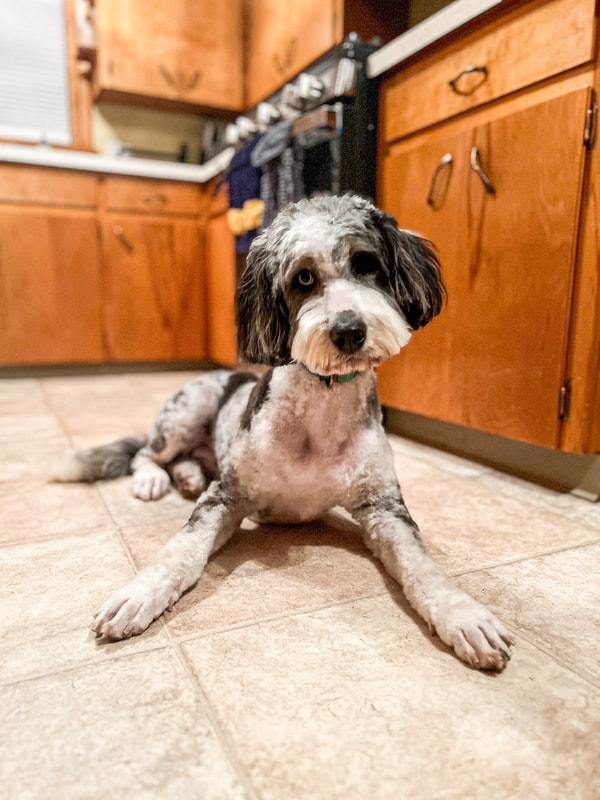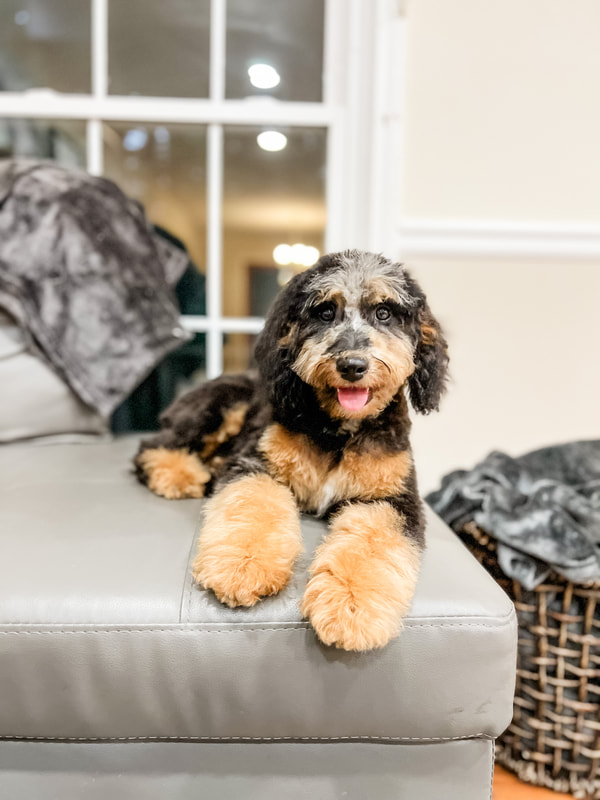|
When helping potential families figure out which breed of doodle puppy or waitlist they are interested in, this is probably the most common question I get: "Is the Aussiedoodle or the Bernedoodle the right breed for me?" So, I figured why not write an article about the differences (pros & cons) between the Aussiedoodle and the Bernedoodle. I have been breeding Aussiedoodles for 6 years and Bernedoodles for 4 years, and I have learned first hand the differences between the two breeds. They are quite similar, but they do have a few differences that are pretty distinct.
I will preface this article with clarifying that all of the differences below depend greatly on the parents of the puppies. We focus our program on low energy/low drive Aussiedoodles and Australian Shepherds as well as calm and relaxed Bernese Mountain Dogs/Bernedoodles. There are definitely very high drive/energy Australian Shepherd and crazy Bernese lines out there, we try to avoid those at all costs to ensure our puppies are balanced, friendly, family dogs. The differences below will be compared from a perspective of breeding these two breeds with intentionality and not just throwing two dogs together. So, with this being said, let's get into the differences. Let's start with the Aussiedoodle. The Aussiedoodle is a wonderful family dog, super friendly, always ready for the next family adventure, but also happy to just chill and relax with the family at home. I have found that the smaller sized Aussiedoodles (Toy & Mini) seem to have a slightly higher energy level than their Standard sized counterparts, but it is not overly excessive. The Aussiedoodles require about the same amount of physical exercise as the Bernedoodle (about 1-2 walks/play sessions per day), but where they vary greatly is in their brain power. The Aussiedoodles are EXTREMELY smart and require mental exercise such as learning new tricks, a job (picking up their toys & putting them back in the basket, etc), treat/kibble puzzles (these help to work their brain in order to get a treat or food), agility courses and things of this nature. Separation anxiety can be a problem (with both breeds), but with any dog, it is important to get them used to their crate. I notice the most problems with puppies who are home all day with a "work from home" parent and are able to be beside them all day long. In this case, it is extremely crucial that you work on crate training each day, even when working from home. Put the puppy in a room or place that is out of sight from you as you work. This will get them used to being ok with not being around you all the time & is a great tool to help house train the puppy as well. The Aussiedoodles are known to be "velcro dogs", you won't do much alone if it's up to them, you will often have a visitor in the bathroom, in the kitchen, or at the desk. They usually have one family member they attach to most, but they definitely prefer to be by their humans rather than alone by themselves. The other thing I have noticed with Aussiedoodles is that they tend to have a higher chance of aggression, I find this usually stems from them not having a strong "leader". Dogs are created to need and respect a pack leader, if you are not strict enough with your training, your dog will learn that and begin to rule you, which can lead to aggression. I know this sounds crazy, but I have seen it first hand, good news is that it can be corrected with working with a trainer. Lastly, the Aussiedoodles are indeed from a working breed line and they can have tendencies to show herding/nipping characteristics, more commonly to younger children. It is important to let the puppies know that this is not ok, they are not doing it out of aggression, but out of their natural instinct. This characteristic tends to be less noticeable as you get more poodle into the mix (f1b, f2b, multigen, etc). The Bernedoodle is also a great family dog, great with kids, a little lower energy (than the Aussiedoodle), and always happy to be apart of the family excursions. They are a little more difficult to house train, and can be more timid in nature rather than outgoing. They rarely have a mean bone in their body and do very well with young children, they are very gentle and loving. They do great with putting up with young kids pulling on their hair/ears/etc. and not reacting in aggression. They aren't quite as velcro as the Aussiedoodle, but they definitely prefer to be around their humans rather than alone by themselves. Crate training is important with the Bernedoodle as well and is also an excellent tool in helping house train the puppy. I have noticed Bernedoodles have a higher chance of digestive issues and often times have to be on specific diets to ensure they have consistent solid stool. Bernedoodles are also notorious for chewing up (& eating) toys/objects that are not meant to be eaten. The Aussiedoodles can do this as well, but the Bernedoodles have seemed to win this award and I have to be very careful with the things I leave out when I am not watching them. Overall, both breeds (when bred well) are great family dogs. With proper training, both breeds are EXCELLENT options. I personally would put the Aussiedoodle slightly above the Bernedoodle if I had to pick, but that is just my personal preference. The Aussiedoodles have such a fun personality and are incredibly smart! As far as coloring, with the numerous colors of poodles now, you can get both breeds in the same colors. I hope this post was helpful to you as you try to figure out which breed of doodle best fits your lifestyle! As always, don't hesitate to reach out to us via Social Media (linked below) or text (330-347-4651) with any questions! -Riley & all of us at Steindoodles🐾❤️
0 Comments
Your comment will be posted after it is approved.
Leave a Reply. |
Archives
January 2024
Categories
All
|
© 2018-2024 by Steindoodles


